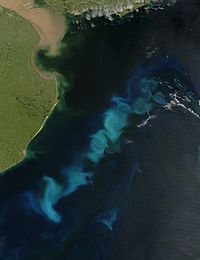
Photo from wikipedia
Engineered nanoparticles (NPs) are considered potential agents for agriculture as fertilizers and growth enhancers. However, their action spectrum differs strongly, depending on the type of NP, its concentrations, and plant… Click to show full abstract
Engineered nanoparticles (NPs) are considered potential agents for agriculture as fertilizers and growth enhancers. However, their action spectrum differs strongly, depending on the type of NP, its concentrations, and plant species per se, ranging from growth stimulation to toxicity. This work aimed to investigate effects of iron oxide (Fe3O4) NPs on growth, photosynthesis, respiration, antioxidant activity, and leaf mineral content of wheat plants. Wheat seeds were treated with NP for 3 h and plants were grown in the soil at two light intensities, 120 and 300 μmol (photons) m−2·s−1, followed by physiological assessment at several time points. High NP treatment (200 and 500 mg·L−1) enhanced plant growth, photosynthesis and respiration, as well as increasing the content of photosynthetic pigments in leaves. This effect depended on both the light intensity during plant growth and the age of the plants. Regardless of concentration and light intensity, an effect of NPs on the primary photochemical processes was not observed. Seed treatment with NP also led to increased activity of ascorbate peroxidase and reduced malondialdehyde (MDA) content in roots and leaves. Treatment with Fe3O4 also led to noticeable increases in the leaf Fe, P, and K content. It is concluded that iron oxide (Fe3O4)-based NP could enhance plant growth by improving photosynthetic performance and the availability of Fe and P.
Journal Title: Plants
Year Published: 2022
Link to full text (if available)
Share on Social Media: Sign Up to like & get
recommendations!